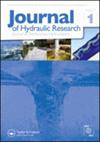Air–water flow in a plain stilling basin below smooth and stepped chutes
IF 1.7
3区 工程技术
Q3 ENGINEERING, CIVIL
引用次数: 1
Abstract
In recent decades, stepped chutes followed by a stilling basin became a standard for spillways of dams. The comprehensive knowledge of stepped chute approach flows on internal air–water flow properties of the hydraulic jump is still too limited for an appropriate design of stilling basins. Therefore, an experimental campaign was performed on a large-scale physical model of a plain stilling basin preceded by a 30° sloping smooth or stepped chute. Stepped chute approach flows induce lower deaeration rates along the jump roller as compared to smooth chute approach flows, indicating longer dimensionless jump lengths, normalized by the tailwater depth. Pronounced bottom air concentrations were observed within the first 40% of the jump length in the stilling basin downstream of the stepped chute. Thus, despite the significantly higher pressure fluctuations, this zone seems better protected against cavitation damage than in stilling basins following a smooth chute.空气-水在平滑的阶梯状溜槽下面的平原静水池中流动
近几十年来,阶梯式溜槽加一个消力池成为大坝溢洪道的标准设计。目前对梯级溜槽引水过程中水-气流动特性的全面了解,对于合理设计消力池还十分有限。因此,在一个大型物理模型上进行了一项实验,该模型是在一个30°倾斜的平滑或阶梯式溜槽之前的平原静力盆上进行的。与平滑溜槽流相比,阶梯式溜槽流沿跳跃滚轮的脱泡率较低,表明由尾水深度归一化的无量纲跳跃长度较长。在阶梯溜槽下游的静水池中,在跳跃长度的前40%内观察到明显的底部空气浓度。因此,尽管压力波动明显较高,但与平滑溜槽后的静水池相比,该区域似乎能更好地防止空化损害。
本文章由计算机程序翻译,如有差异,请以英文原文为准。
求助全文
约1分钟内获得全文
求助全文
来源期刊

Journal of Hydraulic Research
工程技术-工程:土木
CiteScore
4.90
自引率
4.30%
发文量
55
审稿时长
6.6 months
期刊介绍:
The Journal of Hydraulic Research (JHR) is the flagship journal of the International Association for Hydro-Environment Engineering and Research (IAHR). It publishes research papers in theoretical, experimental and computational hydraulics and fluid mechanics, particularly relating to rivers, lakes, estuaries, coasts, constructed waterways, and some internal flows such as pipe flows. To reflect current tendencies in water research, outcomes of interdisciplinary hydro-environment studies with a strong fluid mechanical component are especially invited. Although the preference is given to the fundamental issues, the papers focusing on important unconventional or emerging applications of broad interest are also welcome.
 求助内容:
求助内容: 应助结果提醒方式:
应助结果提醒方式:


